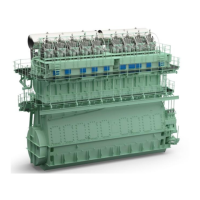Operation
7218−1/A1
Winterthur Gas & Diesel Ltd.
9/ 19
4.2 Function
The WECS−9520 operates the 4/2-way solenoid valve (3, Fig. 4) and servo oil flows
through the valve to the bottom of the central piston. The pressure of the servo oil
pushes the central piston to the top end position. The servo oil from the top of the
central piston flows through the 4/2-way solenoid valve into the servo oil return pipe.
The supply piston opens the lubricating oil inlet and the metering ducts are filled with
lubricating oil.
When the WECS−9520 sends a signal to the ALM-20, the 4/2-way solenoid valve
operates. Servo oil flows to the top of the central piston. The servo oil from the bottom
flows through the 4/2-way solenoid valve into the servo oil return pipe. The central
piston moves down to the bottom end position. The lubricating oil flows at high
pressure through the non-return valve into the outlet ports. The lubricating quills inject
the lubricating oil on to the cylinder liner wall.
The maximum stroke of the central piston is adjustable with a set-screw. Thus, the
movement and the supply rate is equal for all supply pistons.
4.3 Bleed the lubricating pump
Note: Make sure that the cylinder lubricating system is prepared for operation
(see 0140-1).
To bleed the lubricating pump, open the vent screw (9, Fig. 5) (servo oil) in the
baseplate (2) and the vent screw (10) (lubricating oil) in pump body (1).
It is necessary to bleed the lubricating pump:
D At the first operation
D After a long shut-down period
D After maintenance
D If there is a problem during operation (e.g. operating pressure, supply rate).
4.3.1 Lubricating oil
1) Put an oil tray below the lubricating pump.
2) Carefully loosen the vent screw (10) (maximum three turns).
3) Keep the vent screw (10) open until oil that flows has no air.
4) Close the vent screw (10).
5) Remove the oil tray.
2014
Cylinder Lubrication

